Ultimate Guide to Exercises for Lumbar Herniated Disc Relief 2
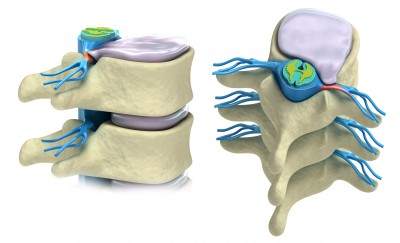
Did you find our previous article, “Disc Herniation Part 1,” helpful but are still battling discomfort? Are you eager to discover exercises that can effectively reposition your herniated disc and enhance your well-being? You’re in the right place.
In this comprehensive guide, we’ll cover:
- Effective Exercises for Repositioning a Herniated Disc: Learn the top movements to gently coax your disc back into alignment, reducing pain and improving mobility.
- Stabilization Techniques to Prevent Disc Displacement: Discover exercises that strengthen your core and back, ensuring your discs stay in place.
Understanding Lumbar Disc Herniation:
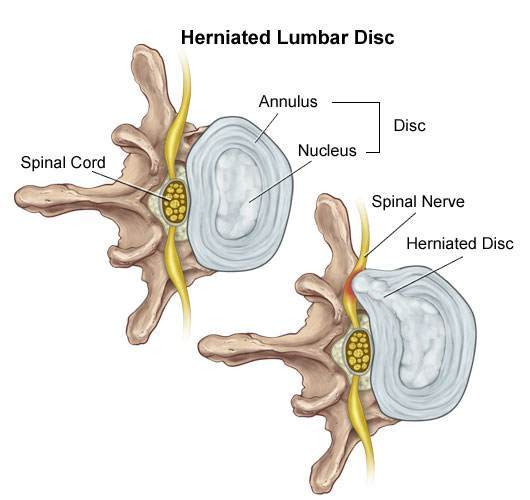
A herniated disc occurs when the disc’s nucleus breaks through the annulus, as shown in the illustration from neurosciences.beaumont.edu. But what triggers this displacement? The primary culprit is forward bending, which compresses the disc (think of it as a jelly-filled doughnut) and can lead to the annulus fracturing, allowing the nucleus to protrude and press against nerves.
Why Does it Hurt?
The disc’s exterior is tough cartilage, while its interior is softer, akin to mucus. Applying pressure on one side forces the inner material to the opposite side, similar to squeezing a doughnut. When a herniated disc or inflammation puts pressure on a nerve, pain ensues. The key to relief is applying counterpressure to reposition the disc.
For a deeper dive into herniated discs, refer to “Disc Herniation Part 1: Best Self-Treatments for Lumbar Disc Herniation.“
How to Apply Counterpressure:
The strategy involves bending your spine backwards or into the extension to shift the disc away from the nerve.
Exercises to Reposition a Herniated Disc: Note of Caution:
Initially, these exercises might intensify your pain slightly. If pain significantly worsens or radiates further down your leg during these exercises, cease immediately and consult a professional.
Exercises for Lumbar Herniated Disc
#1 Prone Lying Lumbar Herniated Disc
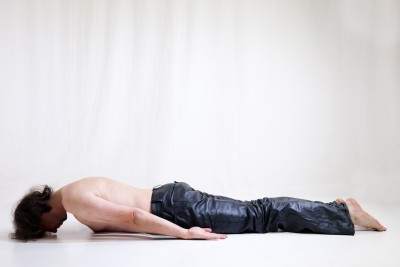
- Lie face down or prone in bed with your elbows tucked in under your side:
- As soon as you get up in the morning you should lie prone (face down). By getting in this position, your lower back becomes more arched, or as doctors say, you increase your lordosis.
- The increased lordosis pushes on the back of the disc helping to bring the nucleus forward into the correct position.
#2 Sphinx pose in Yoga For Lumbar Herniated Disc
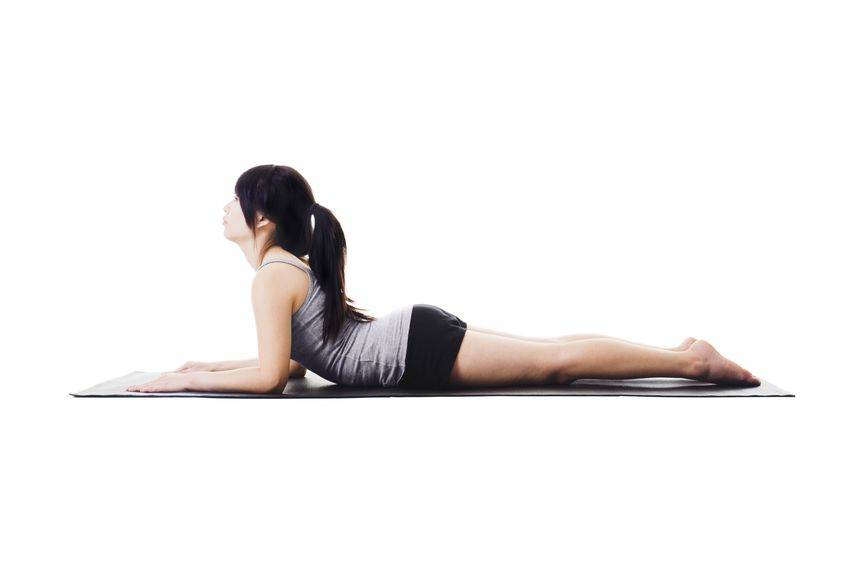
- Get into the prone position lying down on your stomach.
- Next, get on your elbows. If you have a hard time with this position go back into the prone lying position.
- Do these exercises hold each time for 1-2 seconds 6-8 times per set? This exercise can be repeated every two hours throughout the day.
Asses yourself. If the pain has decreased or the pain has moved away from the leg or thigh and into the hip or buttock, this is an improvement. Even if the pain is increased in the back but relieved in the leg this is an improvement and a green light that you should continue this exercise. You also get a green light if there is no difference at all.
- If your self-assessment gives you the green light, move on to the Cobra exercises just below.
- If your thigh or leg pain is worse, then stop right away.
- If your lower back, thighs and legs are the same you get a green light, so move on to the Cobra exercises.
#3 Cobras For Lumbar Herniated Disc
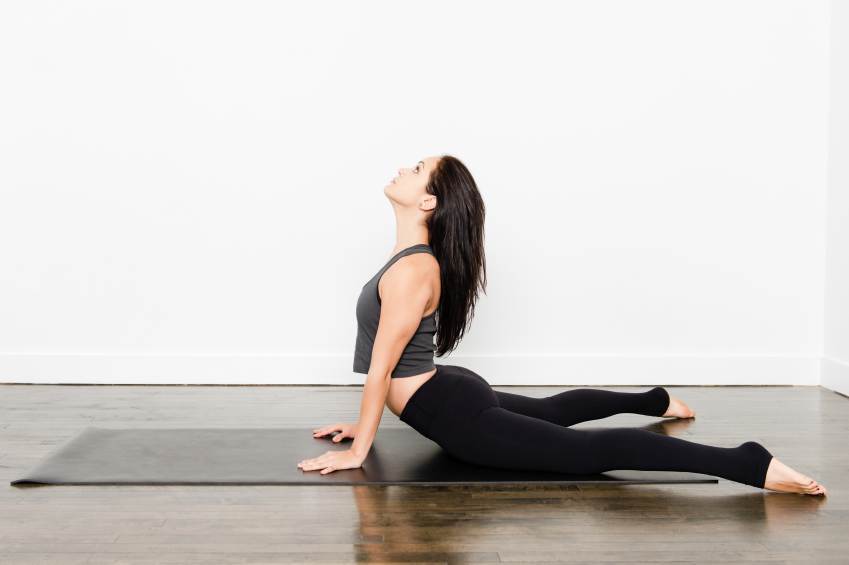
- Lie down face down with your hands underneath your shoulders.
- Push up from as high as you can until your lower back stops you or your elbows are straight.
- The pelvis should still be on the floor and the lower back muscles relaxed.
- Do these exercises hold each time for 1-2 seconds 6-8 times per set? This exercise can be repeated every two hours throughout the day.
Asses yourself. If the pain has decreased or the pain has moved away from the leg or thigh and into the hip or buttock, this is an improvement. Even if the pain is increased in the back but relieved in the leg this is an improvement and a green light that you should continue this exercise. If your thigh or leg pain is worse, then stop right away.
#4 Standing Extensions Lumbar Herniated Disc
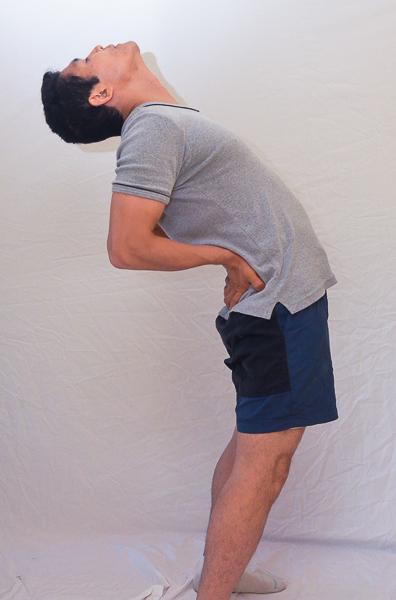
- Stand straight and put your hands behind your hips with your fingers facing down.
- Push your hands into your pelvis so that your lower back arches.
- Don’t use your lower back muscles
- These exercises can be done 6-8 times for 1-2 seconds. This exercise can be repeated every two hours throughout the day.
Stabilization Exercises: Prevent Your Disc From Coming Out By Having A Stable Spine.
#1 Cat-Camel or Cat-Camel For Herniated Disc
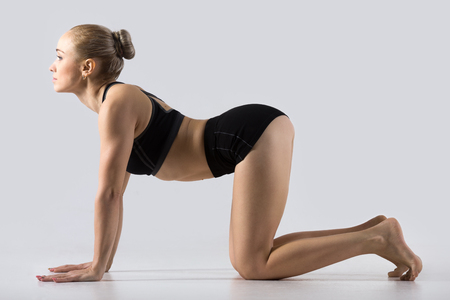
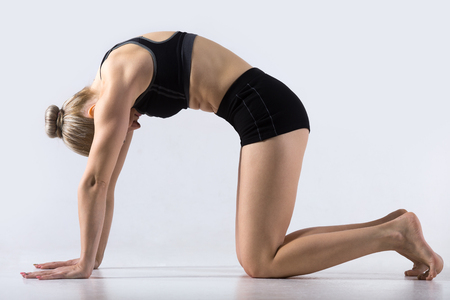
- On all fours with your knees under your hips and hands under your shoulders.
- Inhale and let your belly fall downwards toward the floor as you look up toward the ceiling for 2 seconds.
- Exhale and arch your back up as far as it will go or until you feel pain. You should not feel pain with this exercise, otherwise you are going too high.
- At the same time bend your neck forward and look toward your navel.
#2 Curl-Ups
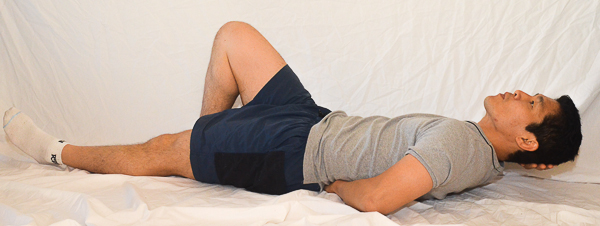
- To start, one foot is bent and the other is straight.
- One forearm goes under the arch of your lower back to support it.
- The other arm is supporting your head.
- Your head and neck come up as one block until your shoulder blades clear the floor.
- Do three sets of 5 working your way up to 10. If it’s easy, then hold for a couple of breaths.
#3 Squats
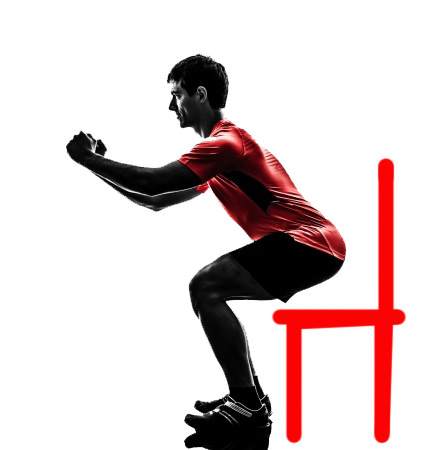
- Stand in front of a chair as if you are going to sit on it.
- Stand with your feet facing slightly more outward than your knee.
- Make sure your butt comes out, and keep lowering your butt until you touch the chair.
- Practice 3 sets of 10.
#4 Bird Dog
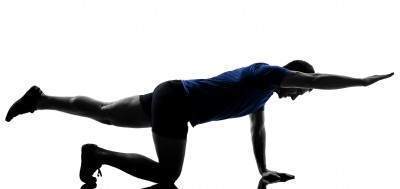
- Get into a crawling position with your hands and feet shoulder-width apart.
- Harden your core by contracting your abs and lower back. This is called bracing.
- Lift your arm first. If this is easy, then lift your leg only. If that is easy, then lift the opposite legs and arms, for example, right leg, and left arm.
- Want to make it tougher? Try lifting an arm and leg on the same side.
- 3 sets of 10. If you are shaking a little or cannot balance quite right, you’re doing the right exercise for you, i.e. lifting just the leg or arm might be easy, but lifting opposite arms and legs might put you off-balance a bit. Make sure you are stable before going to the advanced bird dog.
Tell us what you think in the comments below and like us on Facebook. This Toronto Downtown Chiropractor will answer all questions in the comments section. Let us know your vote for the best Toronto chiropractor in the comments section.
References
1. J Med Genet 2002;39:387-390 doi:10.1136/jmg.39.6.387


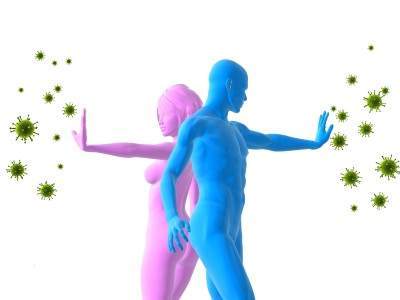

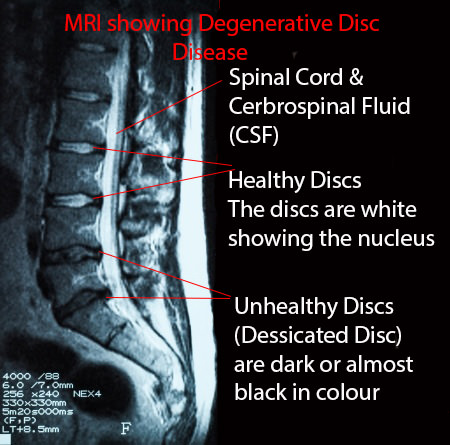
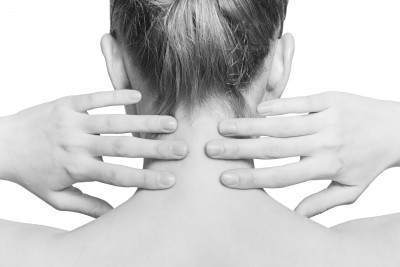
Dr. Ken,
I’ve had several bouts of severe right leg pain over the last few years (typically lasting only a few months and then recovering pain free) until last March (2015), which became significantly more debilitating than any of the previous (3) episodes. After being bedridden for two weeks, I went and had MRI that revealed 2 herniations. Almost 13 months later, my pain has significantly reduced, but not all the way gone. At 47, I was previously very active, running and working out, and am now just getting back to exercising (walking 4-5 miles, 4-5 times at week at roughly a 16-minute mile). Here are my questions:)
1) – Can the annulus repair itself once tore, or is it always damaged with the threat of additional nucleus oozing out and pressing against the nerve?
2) – Could my disc injury cause a secondary issue in my right hip (I tend to have separate pain on the outer part of the hip and just right of my groin)? If so, what would you recommend to fix that issue?
3) – Am I risking further injury (or regression) by attempting to run again?
Unfortunately, the progress has been much slower than I had hoped, and I’m anxious to get back to an active pain free life.
Thank you for your time and insight.
Author
Thanks for your questions Rick.
1. Yes the annulus does not repair itself. Once torn it causes an instability in the disc and if torn through a decompression like a balloon deflating. Once this happens the body doesn’t repair the disc. It attempts to but not really well. However when the disc comes out you can put it back in. Also you can maintain your disc in that position.
2. First it could be related to the disc as a referral. Fixing the disc will help the hip pain if they are part of one problem. If not doing hip exercises often by doing repeated hip flexor stretches helps.
3. You need to be able to bend fully forward without pain before running or you will get worse.
Hope that helps your disc herniation.
Thank you Dr. Ken,
One last question. When you mentioned “bending fully forward”, is this standing straight legged and touching the toes, or is it standing and bending forward with the back flat?
Thanks again,
Rick
hi dr Ken, I am a 62 yoa and am a long haul truck driver ( 18 wheeler ). On october 1, 2015 i had an accident. I struck a vehicle in the side at about 30 mph.a few days later i had an mri which reads as follows: findings; alignment is within normal limits.vertebral heights are all maintained. There is no acute fracture,dislocation or subluxation. Marrow signal is normal throughout and there is no compression deformity. the conus medullaris is at L1 level with normal signal. L5S1 there is broad-based disc bulging/herniation by 3 mm. there is some effacement of the anterior thecal sac. some slight impingement is noted of the exiting nerve roots that is worse on the left.Findings are further aggraveted by hypertrophy in the posterior elements. I only have pain in lower back down into top of buttocks.Have been taking therapy now for 5 months. I have refused surgery wih a neurosurgeon as i think it is to risky and per my family drs. advice.I would like to return to truck driving but do not want to make injury worse to where i would have to have surgery. I also cannot push a grocery buggy in a store or the pain becomes bad.pls snd me your advice on returning to driving a truck. Thank you so much!!
Author
Thanks for your your question Benny. Sorry to hear that you are not working. These exercises are designed to help just such a situation as yours. If you do the exercises diligently you will likely get better.
If the exercises increases the pain, numbness or tingling or makes the pain go further down the buttock or even to the thigh then you are getting worse. You should then stop the exercises.
Also when sitting I would use a lumbar support roll and don’t sit on couches, just straight back chairs unless you feel better sitting on couches, which is not likely given what you have told me so far.
Hope that helps your herniationed disc.
Hello. I have a herniated disc on my L5-S1. I was wanting to work out to make my back stronger as well as get fit all around. Arms, legs, abs, stomach etc. I’m not sure if riding a bike will help or worsen it. Any help much appreciated. Also my end goal is to get toned a build muscle in certain parts of my body. Can I lift weights, treadmill, stationary bike? I’m looking to join a fitness gym. My pain recently has been mild. 6 months ago I could barely walk but now I have full functionality but with moderate pain at times. Thank you Dr. I hope this makes sense.
Author
Thanks for your question Luis. Then you should go over exercises with a personal trainer that knows what they are doing. However I find personally they know how to train but most don’t know how to rehab a lower back. Usually a chiropractor or physiotherapist knows much more and can give you guidance. Also doing the exercises in this article will help.
Hope that helps your herniated disc.
Dear Dr. Ken, I have a herniated disk that effected my left leg. Its been extremely painful. I have been doing exercises for 2 months now and its improved a little. I am now going back to work and wonder if you can recommend a office chair for this kind of low back pain. There are so many and I don’t know what would be best. Worried.
Thank you in advance.
Carolyn
Author
Thanks for your question Carolyn. Asumming that your disc herniation is the typical type in that it is going out backwards. eg. posterior L5-S1 disc herniation. Posterior means backwards. If that is the case then a lumbar support roll will likely help.
http://www.amazon.com/Original-McKenzie-Lumbar-Roll-Standard/dp/B000H48WYA?ie=UTF8&keywords=lumbar%20suport%20rol&qid=1460041561&ref_=sr_1_sc_1&sr=8-1-spell
Hope that helps your disc herniation.
Thank you Dr. Ken. I really appreciate your response. You are correct about my disk herniation. I got a Obusforme hair and I will purchase this which I’m sure will be a great addition. I like the fact I can use it anywhere. I still have quite a bit of numbness in my left leg. How long does this last in your option?
Author
Thanks for your question Carolyn. The recovery is variable from years to days. Most people take months. First is if you continue to aggravate the problem it takes longer. If you do the exercises wrong or not often enough it won’t get better. Sometimes you need to go harder with exercises or more often but I can’t tell you to do that as I don’t know how you are responding really. All I know is you are a little better after two months. Also when it’s going down the leg it’s better to customize the treatment, which I cannot do based on the information I have.
Hope that helps your herniated disc.
Originally, I had severe pain down the leg. Now after doing the exercises, (every 2 hours) it has moved more into my lower back and the pain isn’t to bad. So I must be doing something right. The numbness is still there though as I said. Its been 3 months now since I got the herniated disk. I seem to be on the right track. I appreciate your comments. Thank you 🙂
Author
Thanks for your comment Carolyn. Feeling pain in the back and even more pain in the lower back with less pain in the leg means that you are getting better. Glad things are improving for your herniated disc.
Keep going with the exercises everyday.
Thanks Dr. ken for all the information i have a question do you think sleeping in the floor would help or harm my bulge disc?
Author
Thanks for your question Edwin. For most people it help their herniated disc. I cannot say for you.
Hope that helps your herniated disc.
Thanks a lot Dr Ken… Your response makes me calm.
Last couple of nights i have woken up with strong sense of electric shocks flowing throw my leg and have woken up. I know it can be a symptom of Restless Leg Syndrome but i have never had a problem with it before and timing makes me think of has something to with disc bulge nerve impingement but not Restless Leg Syndrome.
Any opinion?
I like to use to sleep on my back but am trying to sleep on my side. Only thing different over last 2 days is that i have put pillow between my legs. Maybe that’s causing it since it forces one position for too long.
Author
Thanks for your question Varun. Try sleeping on your lower back with a small pillow underneath your back. If that’s comfortable try tying it around your waist so it doesn’t move out of place.
Hope that helps your disc herniation.
Thanks for all your advice here Dr. Kent.
For last month I have a low back pain though I would say its mild. Whats bothering me more is the fact that I have tingling in my left feet and some warm heat flashes on shin that last 1-2 secs and go away.
Here are the MRI results:
* Straightening of normal lumbar spine curvature
* There is congenital spinal canal stenosis, AP dimension, throughout the lumbar spine
* The vertebral body heights are normal. There is disc space narrowing at L5/S1 level and and L1-L2 level with mild disc desication. There is a small endplace Schmorl’s node at L1-L2 level.
* There is no bone marrow or soft tissue edema. Bone marrow signal is normal.
* The conus is normal in size and signal, located at T12-L1 level.
* At L1-L2 level there is a mild disc bulge which flattens the ventral margin of the thecal sac. There is no significant foraminal stenosis.
* At L4-L5 there is a disc bulge which results in mild central canal stenosis with mild bilateral foraminal narrowing. There is a contact of the existing L4 nerve roots, left greater than right.
* At L5-S1 there is a central disc protrusion which contacts the ventral margin of thecal sac and contacts the descending right S1 nerve root. There is mild bilateral foraminal narrowing.
* Mild acquired degenerative disc disease.
Any idea what all this means and how I should proceed. Doctor says to continue with PT, which I am but wanted to make sure I am on the right path.
Additionally these MRI results are from 3 days ago and I was in a low impact rear end fender bender last night. While the impact wasn’t bad, I am worried because I already had all this on my MRI. My tingling has gotten worse in the feet, and back of my thighs are very tight (can feel bone or nerves) which wasnt the case before.
Thanks for your help
Little more about the symptoms….
Low back pain but manageable, going down to the top of the butt. Slight pain sometimes but very manageable behind the knees and thighs. Can also sometimes feel little dull pain behind my heel.
Hot flashes 2-3 seconds long lower leg. Tight calves and back of thighs.
Symptoms that bother me most is tingling in feet and a bit of tingling in butt and sometimes in scrotum.
Symptoms are worse when sitting or laying. Better but sometimes still there when up and about.
Don’t feel muscle weakness or foot drop or anything, atleast I dont think so. I am abke to stabd walk on my heels and toes.
Thanks
Author
Thanks for your question Varun. There is a lot going on but unless you have symptoms in both legs only the L45 disc is causing pinching of the nerve. The others aren’t symptomatic so don’t worry about them. You should first try the exercises that your physio is giving you. Give them a chance. If after month there is no improvement they should be changing their treatment if not find someone else. At that point you should try the exercises here in this article.
Basically the lower the symptoms weather numbness, tingling or pain the worse you are getting. The higher the symptoms go means you are getting better. Hope that helps your herniated disc.
Hi Dr Ken , I appreciate your time for replay.
yeah, you’re right, I didn’t explain the whole MRI info, ’cause its long to type it and basically most of it is unremarkable. Here’s what proceed and I considered would be important .
Impression:
1-Large central to left paracentral posterior disc protrusion L5-S1 with posterior displacement left S1 nerve root.
2- Moderate to severe bilateral L5-S1 neural foraminal narrowing.
3- Mild central canal stenosis or neural foraminal narrowing L4-5.
findings:
5 Nonrib-bearing lumbar -type vertebrae body. Vertebral body height are maintained. No listhesis. Mild to moderate disc desiccation L4-5 and L5-S1 with bilateral L5-S1 disc space height loss. No evidence of fracture , infiltrative narrow process or spondylolysis . Mild discongenic degenerative endplate marrow signal anterior anterior inferior endplate T12. No paraspinal mass. Conus terminus normally at L1-L2. Conus and cauda equina signal appears normal.
***6 months ago has been experiencing a pain in the lumbar area specifically when I bend down to pick something up and even more when I woke up in the morning, frankly I have never felt pain in the buttocks or down the leg. I went to see a couple of chiropractors they made some adjustments ,decompression and acupuncture and no relief, until I went to see this third and He recommended a MRI. (Strangely none of the 3 has recommended me any single exercise or stretching) that’s what I meant ” none has given the spot ”
Currently I’m going regularly to get adjustments and decompression, even T.E.N.S. therapy.
In conclusion, for a week I’ve been doing the exercises you recommended in your web site and I felt a little improvement, but not sure if I’m doing the right exercises (cobras and cat-cow).
Hopefully to get the best advice from you .. Sincerely…. Thanks a millions !
Author
Thanks for your question Thomas. Just do the exercises here in this article as it should be safe to do so. If the exercises increase the pain or cause numbness tingling or pain down into the buttock than you should stop the exercises as you are getting worse. You should have these exercises supervised by a health professional.
Hope that helps your herniated disc.
Hi Dr Ken, first the all, I would like to congrats you for being so honest and charitable empowering people at no charge!
Here’s what MRI found on my lower back:
L5-S1 Small broad- based disc bulge with super imposed central to left paracentral posterior disc protrusion measuring 6 mm anterior posterior by 11 mm transverse at the base. Mild /moderate facet arthrosis. Resultant moderate asymmetric left central canal stenosis with posterior displacement of the descending left S1 nerve roots. moderate to severe right greater than left neural foraminal narrowing.
**Please translate me what’s this exactly this means, since I’ve visited 3 chiropractors and none has given to the spot , I also don’t think that requires surgery, because the pain is local in the lumbar area and I never run into the buttock or leg, However it’s painful when woke up in the morning & disappear during the day, when Walking or apply heat.
Thankfully ……… Truly yours!!
Author
Thanks for your question Thomas. See that’s the thing. Lot of people would recommend surgery unfortunately. You would be right though even though the MRI isn’t so good it depends on the symptoms.
So I don’t know what you by “none has given to the spot”. I have no idea.
Basically the MRI is saying that your disc is sticking out so that it is pushing on the the spinal cord (actually the left overs of the spinal cord called the cauda equina). If you read the article more carefully you will know what I mean.
This is pinching on the left nerve at S1. Also they are saying that on both sides the hole for the nerves that come on either side of from between the vertebrae is being blocked probably by the disc. You only gave me part of the report and so I have to make an assumption.
Hope that helps your probable disc herniation.
Hi Dr. KEN, its me again.
1. I read online the sleeping position for herniated disc like mine is to put a rolled towel below low back to maintain the curve. How about sleeping on the side?
2. One of the big 5 exercise you mention which is bird dog reverse involve raising bent leg and arms while lying down face up. Isnt raising bent leg not recommended for herniated disc?
3. I read online which widely recommended sitting on medicine ball, knee 90 degrees arms down back straight and do mini bounce on the ball to increase blood flow to herniated disc. Whats your take on that? Because sitting and bouncing is a bad combo for herniated disc like you mention in your website.
4. I felt pain in my lowback also when I carry something arms straight away from the body or when I sneeze, even though I dont hunch my back.. I think it has to do with my weak lowback muscle. What do you think?
Thx again.
Author
Thanks for your question Rob.
1. When sleeping on the side if you tied a roll that extends from the lower back to the side you can help both side and back sleeping positions.http://www.amazon.com/OPTP-Original-McKenzie-night-roll/dp/B00KQVVBI8
2. No. Especially as you are keeping your arch in your lower back it’s totally fine.
3. First there is no blood flow to the disc. All traces of blood vessels disappear by the time you are 20 years of age. That’s why most people under 20 don’t have disc herniation pain. If they actually said that on the website they really don’t know and are making assumptions. I have the research articles to back it up.
4. It has to do with load. When you carry something you put more pressure on the lower back discs. The heavier it is the more pressure put on the disc. Think of the jelly doughnut again. Put a mug on top no problem. Put a 2 lb or 1kg weight on top and the doughnut jelly will squish out. You have to have damaged your disc significantly enough for smaller loads to cause this although if you do the exercises and get the disc back in your tolerance to more load will increase. Your doughnut may be able to take 10 lbs as an example.
Rob I honestly thinking you are getting overly analytical. There are tonnes of information on health that is simply wrong. More isn’t better. Reading a lot of the wrong stuff only confuses things. The source of information and who is writing the information is the most important. Just stick with your trusted sources by professionals that read the research. The person that wrote about blood flow for example hasn’t read the research.
Hope that helps your disc herniation.
Hi Dr Ken,
Thx for the reply and the link.
I will focus on the exercises you recommended in this page.
Thx
Author
You are welcome Rob.
Thx for the info you are very kind.
Most of the physiotherapists i met or heard about are stingy with information with aim for patients to keep returning, more income. But of course not all, just some.
I will do the exercise diligently.
Author
Thanks for your comment. Glad this has helped your understanding of your disc herniation.
Hi Dr Ken,
I also have questions regarding the frequency of exercises you mention above.
1. The cobra exercise is recommended for every 2 hours which is around 6 times a day. Does that apply to the strengthening exercises as well such as crunch, bird dog and squat? Eg each session consist of 3 exercises 3 set of 10 reps for each exercise.
Because usually people just do 1 session in the morning and 1 in the afternoon for the strengthening exercises.
Thx
Author
Thanks for your question Rob. Strengthening when rehabbing and strengthening for power and strength is different. Once a day sometime twice a day for the rest of the exercises are fine. The cobra should be done every 2 hours though. That means up to 8 times as most people sleep 8 hours a day. You have 16 hours left so 8 times in a day for the Cobra.
Hope that helps your understanding of the exercises for your herniated disc.
Im 22year old my backbone bulge l4 l5 and herniation how to recover and i have office job my working 9 – 11 hours daily seating so how can i recover l4 and l5
Author
Thanks for your question. Assuming that you were diagnosed correctly than you should do these exercises in this article. You should first read the article, then you should do the exercises. Also read part 1. If the pain, numbness, tingling goes further down the leg than you are getting worse. You should stop the exercises. These exercises should be supervised by a health professional.
Hope that helps your possible disc herniation.
Thanks for the reply Dr Ken, I really appreciated it.
I read on your website that recommend superman exercise for fixing posture.
1. Is superman exercise ok for herniated disc?
2. The crunches exercise you recommended here is the farthest only raise up til clear shoulder and neck, so thats the farthest we can go even in the future when we are stronger?
3. The strengthening exercises you recommended here at some point of training will become easy to do, such as the squat can we add light weight/resistance band eg 5 kg progressively to make it more challenging? Of course without pain.
Author
Thanks for your question Rob.
1. Superman is fine for herniated disc but Cobra is better.
2. You should never go further.
3. You can certainly add weights and do lunges and step-ups as well.
Hope that helps your disc herniation.
Hi Dr. Ken.. The article above is good. I am 27 Yr old and I have Herniated Disc at L3-L4, L4-L5 & L5-S1 because of weight lifting at Gym for almost 2 years. I have been doing almost all the exercise shown above for past two and half months. My Pain has also got reduced but still I find some pressure on my lower back while starting walk after sitting for a while in office. also I having little pain while trying to twist. kindly help me with exercises to Decompress my Lumber Spine.? And is it possible to send back the bulged disc to its original possible by exercise.? or strengthening the back is only option.? Will it cause any problem in future if I stop doing exercise in future.?
Author
Thanks for your question Ranjeet. You need to increase the frequency of the Cobra up to every 2 hours. Also you should try to breath out at the top of the cobra.
Hope that helps your disc herniation.
Thanks for your reply Dr Ken.
1. How about this strecthing exercise such as lying face up knee bent and then move the both bent legs together to both sides, while upper body stay still (knee rolls)? Cause its not painful but its a twisting exercise which I read from your website that twisting movements contribute to herniateddisc. Yet on the internet its recommended commonly.
2. I live in 3rd world country where some of the toilets are old version which dont have seat and have to squat down. When I squat down all the way down I felt pain in my low back. I think squatting all the way down to the floor is like the child pose that cause flexion at my low back. I shouldn’t do it yet until it heal properly right?
Thanks
Author
Thanks for your question Rob.
1.You are right twisting is not recommended as it will contribute towards disc herniations. If you look at the research by Dr. Stuart McGill and my own experience has been the same, twisting is not recommended.
2.You’re right again Rob, squatting down is flexion for the lumbar spine which will put out most types of disc herniations.
Hope that helps your disc herniation.
Hi Dr Ken, I have experienced sciatica twice already. I have herniateddisc from cycling bending forward and bad posture. Since 2014. The cobra exercise helps a lot. I feel pain at my lowback when I arch my back such as when picking stuff from the floor. I also feel pain at my lowback when doing the childpose streches and little pain at lowback when pulling my knee to chest or whenever the spine streches. When I pick up stuff from the floor I have to maintain a straight back and sort of squat down like the way you described the correct way to pickup things for it to not cause pain. I live in a country without mri. I have asked physiotherapist and she suggested cobra exercises. I also have forward head posture and history of pinch nerve in my neck that radiates to my arm.
NowI can walk with mild pain on the leg from the sciatica. Im male 33 years 70kg. Cobra exercise cure my 1st sciatica , now im doing it and my sciatica is better. But I still cant sit for long and cant arch my back (arch meaning bending forward my lowback or hunching which I know you dont recommend). I also feel low back pain when doing this decompression technique by lying face down and putting pillow under my belly which streched my back.
My questions are.. .
1. Whats your recommendations?
2. Is it forever I can not arched my back anymore when picking stuff? Because the correct way you suggested in picking up stuff from thefloor is not always comvenient in tight spaces.
3. Can I ever fully recover?
4. Should I do the childpose and knee to chest streches even it cause little to mild pain depends how far I streched?
5. A friend suggested leg lifting exercises, starting from bent leg progess to straight leg raise. But I read from your website that leg lifting cause herniated disc. What do you think?
Thank you very much, you touched a lot of peoples lives. You are an angel.
Author
Thanks for your questions Rob.
1. You should do the cobra exercises every two hours but make sure you go as high as possible.
2. Yes it should be forever.
3. You can but you have to be diligent with the exercises.
4. No definitely not.
5. Don’t do leg lift either.
Hope that helps your disc herniation.
Sir i have problem in my spine mri report shows disc dehydration is seen at l5-s1 and loss of normal lumber lordosis is seen iam taking medicines my weight is 95 kg this problem csn be heal or not
Author
Thanks for your question Jam. Without telling me symptoms I cannot help you. Why don’t you try explaining in detail about your symptoms. You don’t have too much on your MRI that will cause pain. Besides MRI often don’t correlate to pain.
Hope you understand it takes a lot more information to begin to help lower back pain.
Hi Dr.Ken,
I’m 21 years old male.. I’m very active and sportive .. a year ago, i started realizing the numbness and tingling on my buttock down to aside of my leg whenever i sat for a long time… at first, I thought it’d be ok and kept playing basketball and lifting weight as usual. However,the situation was getting worse with a constant pain. Then, I had MRI and the doctor told me that I had a herniation at I4/I5 and I5,/S1.. Therefore, I took off completely all the activities and I went swimming and doing all the exercises for herniation which i looked up on the internet. Currently, i rarely feel that pain and sometimes it’s just on and off and I’ve been got back on lifting but not too hard. I already quit basketball because i’m afraid of causing to the pain again. what should i do right now? can i just play lightly basketball again? should i keep up swimming and doing exercises for herniation?. Please give me an advice as soon as possible because i’m really too young for this symptom and it’s pretty much scared me . Thank you so much doctor
Author
Thanks for your question Tra Loung. Generally basketball is is better than weight lifting. I see a lot of people as a result of weight lifting for their back. It is rare to see somebody come in for their back in basketball. Most of the time they injure their limbs not their lower back.
1. Swimming is helpful
2. I would do the exercises here. If the problem starts going further down the into leg than you are getting worse and you should stop. Like any exercises they can make you worse so they should be supervised by a health professional that is familiar with the exercises. Not a medical doctor but a chiropractor or physiotherapist.
Hope that helps your disc herniation.
Thanks for your quick respond doc. When I’m working out , i try to avoid any exercises that cause to pressure onto the spine like deadlift , squad and so on. I just mainly do heavy enough weight ( not too heavy), and cardio ( running , treadmill ..) So, like you said it is possible to come back in basketball?. Since this sport is like a part of my lifestyle. So, do you have any recommendation for me ? . thank you so much.
Author
Thanks for your question Tra Luong. Like I said basketball is fine. The heavy weight not really at this time. Wait till you have full motion going forwards backwards and sideways with your lower back.
Hope that helps your lower back pain.
I am 21 yr old Male…last oct i have a hard pain in lower. back centre..i can’t bend because of this pain..only for a single day..but after this i got started pain in my right leg right side just below the knee…when ever i sit and get up..i have to face hard pain in my nerves…but as i play ..run..then there is no pain..so i neglect it..But now in a jan..it goes worst..i cant make my face down,,cause there’s a hard pain in my right side lower back just above the hip..and the lower leg..(in a nerves) very hard pain..Doctor suggest me take out a MRI
MRI report… impression- Annular tear with generalized posterior bulge and mild right paracentral protrusion of the L4-L5 intervertebral disc with compression of the traversing right L5 nerve root.
After spine dr. Suggest me to rest for 2 week. Single day 22 hrs..after this..1 week physiotherapy..As physoitherapist suggest me ur exercise. Now i have a less pain as compair to prvious day pain ,but now ..i have pain in a lower back and a hip in a muscle not in a nerves. And there is still pain in lower leg ON OFF Pain in a muscle..whenever i put my leg straight or stand..It is still difficult for me to bend or after sitting to stand without pain something doesn’t make me to stand errect for few seconds. I cant raise my leg while sitting if i try to do,i got huge pain in a lower leg or back. So i have to know when i will get fully normal like previous or any surgery needed to make me normal pls help…
Author
Thanks for your question Asad. If the pain moved up to the buttock from the leg or your right leg pain if it was constant became on/off then you are getting better and you need to continue the exercises doing the exercises more frequently.
You have a physiotherapist looking after you so I will entrust your physiotherapist to help you with your exercises and guide on the frequency and intensity with which you must do the exercises.
Hope that helps your herniated disc.
Hi Ken,
I have a herniated disc now for more then a year. The situation is deteroriating. I did excersizes for the first 6 months, but based on hospitol advice (neurologist) I stopped them for about 4 months and the situation got worse. I have tried several physiotherapists, manual therepists, chiropractors and I am now with a ostheopath staring doing excersizes again. I have decided that I cenrtainly do not want to do a surgery and will try to fight my way out thru therapy and excersizes. I feel your excersizes above help and am doing now for about 5 days. no positive effects though yet. When are positive effects to be expected once carrying out the excersizes above? Many thanks for your answers, advice and support in advance.
Author
Thanks for your question Peter. Assuming that these people have the correct diagnosis which is not always the case than you should start getting better within a few days. Either it’s a very severe disc herniation or the disc herniation is not sticking out the back but in another direction or the diagnosis is wrong. If it’s any of the three the exercises won’t help as you need customized exercises. In that case I can’t help you unless I examine you.
Hope that helps answer your questions regarding herniated discs.